|
|
Gasmask Binoculars
Introduction
I. A short history of the production of Gasmask binoculars
1. The Nedinsco Factory establishment
II. Construction of the eye lenses
III. A few words about Gasmask binoculars models
1. Nedinsco binoculars
- 6 x 30 models
- 7 x 50 models
- Nedinsco logo
2. Carl Zeiss Gasmask binoculars
- D.F 6 x 30 Carl Zeiss Jena – 1934
- 7 x 50 H Carl Zeiss – 1938
- 7 x 50 Carl Zeiss Flak (Küste) – 1940 –Antiaircraft (Coastal)
2 a. 7 x 50 Carl Zeiss war production:
– 7 x 50 blc; rln
3. Gasmask produced by other Company, during the war
- 8 x 50 dow
- 7 x 50 bmk - Srb & Stys, Fabrik praziser Messinstrumente, Prag XVII, Kavalicka 208 and short history of the Company
IV . A few words about Eyecups rubber
Introduction
The idea of the binoculars, named shortly - Gasmask, was born when the gas masks became military equipment. The Gasmask had begun to be used and wear in army after the tragic events in WWI, when during the military action were used the Chlorine, phosgene and iperyt gas (mustard gas) and killed tens of thousands of soldiers.
A very interesting article about Gasmask is written on the web site:
http://www.woodlands-junior.kent.sch.uk/Homework/war/gasmasks.htm
Dr Stephen Rohan writes:
“The rubber eyecups […] may be pushed down to allow the observer to see the entire field of view while wearing sun glasses or gas mask. When use without glasses the eyecups can be pulled upwards to prevent extraneous light form hitting the eyepiece and therefore causing interfering reflection in the field of view. […] The binocular can be held several inches from the viewers eyes while still enjoying nearly the entire field.”
The binoculars were designed for observation of many objects and using in many environments:
- Marine artillery - D.F 6 x 30 Carl Zeiss Jena in this article;
- Antiaircraft coastal observation – 7 x 50 Carl Zeiss Flak (Küste);
- Searchlight and sound locator units – read about “Kriegsmarine”
The Gasmask binoculars were used on U-boats as well. The sailors wore sunglasses, because of the very strong reflection of sunlight from the sea waves. The Gasmask binoculars used on the U-boats were fitted with containers of a silica jell, on the bottom hinge bridge.
I. A short history of the production of Gasmask binoculars
1. The Nedinsco Factory establishment
Presumably the first information about these kinds of the binoculars came from the CZJ Nedinsco, Venlo the Nederland. The Company was opened in 12 January 1921 and began producing the Carl Zeiss items.
After the WWI the Treaty of Versailles established a strict control on the production of arms equipment and complete control over the factories produced these items. Among the factories was Carl Zeiss Jena (CZJ).
In 1920, following negotiations of the Carl Zeiss Jena’s representative - Franz Kaumanns, with the chocolate factories in Venlo, the factory was bought.
The representative of Carl Zeiss has been opened in -‘s Gravenhage. The Carl Zeiss production machines have been installed in Venlo.*)
In 1996 the history of the Nedinsco factory in Venlo was published, by Frans Hermans- “Een up-to-date modern gebouw’ Het Nedinsco-complex te Venlo 1921-1945” (“One up to date modern building’ The Nedinsco complex Venlo 1921 – 1945”) – Published Venlo 1996; ISBN 90-802392-3-2. The book is based on many original documents and other literature.
As written in the book:
“Through many organizations in neutral countries such as Holland and Sweden CZJ has built new industries. Thanks to a man that sympathized with Germany, the Carl Zeiss factory has managed to avoid the restrictions of the Versailles Treaty.
The great stocks of expensive equipment from CZJ were shifted to Holland, by illegal transport in thousands of boxes.
In this way an agent of CZJ Franz Kaumanns, who was established in The Hague, because he smuggled most of the inventory of CZJ factory and placed it in the warehouse at Vlissingen. In 1920 Kaumanns bought an inactive chocolate factory where he placed the valuable equipment.
In the meantime, in the greatest secrecy CZJ built the camouflaged company in the Netherlands. After the official opening the factory, in 1921, the production began quickly in Nedinsco.
The development of the Nedinsco factory and consequently the rescue of German optical industry, are described in various sources in detail.
In the Company archives in Jena is the very detailed description of a journey to the Netherlands , dated 12 February 1921, one of the directors from Zeiss - Forstmann, to further explore the business climate, and to meet optionally collaborator men.
The Nedinsco development:
Extension of the factories in Venlo proceeded with great success in 1921, subsequently the entire complex of buildings was built.
In the 20's, the German CZJ continue to preserve the secret nature of the business. that it was a German company, not Dutch.
In 1924 Nedinsco was accepted as one of the native plants. And next around 1930 the Venlo port was opened.
In 1926, Nedinsco director Erich Shreiber published, that the provisions of the Treaty of Versailles are obsolete. He proposed to gradually move the production to Jena. It was a rumor that Nedinsco was out of favor of Carl Zeiss Jena. But the problem was outside of the factory in Venlo, because the banks were reluctant to give mortgages to the factory Nedinsco. However, the leadership in Jena (Director Forstmann) believed, that this situation should be maintained.
The reaction of the Directorate of Jena proves that the factory in Venlo played a major role in the survival of the German optical industry in the years from 1919; the years of the Versailles Treaty until 1933 when Hitler came to power.
Nedinsco manufactured on a big scale very modern products. Catalogs which survived in Jena factory shows such instruments as measuring devices, periscopes, cameras, heliography, military spotlights, etc.
Working conditions in Nedinsco were very good. Former employees recall them ever since. As the first factory in the Netherlands it had its own newspaper, and had a football club. Social aspects of Nedinsco factory were closely monitored and were the same as the CZJ.
In 1944 the building complex was bombed by the Allies and largely destroyed.
It is interesting that the skyscraper has survived the bombing; the building in which periscopes had been made ​​, which is funny. Low buildings do not survive and the tall building has survived.”
The authors of the book concluded, that “the plant was of great economic and social importance for the city of Venlo, and in a positive way created a part of Dutch history.”
The translation has been kindly made and transmitted to us by Eva Meijer from the Nederland.
Robert Forslund in his book: “Swedish Military Binoculars. The Best Possible Binoculars”; Published Leezen 2009 says:
“Around 1927 Nedinsco started to produce a new design of binoculars with oculars suited for use with a Gasmask or with protection glasses. On the 3rd January 1928 Norinab, the Swedish agent for Nedinsco, writes to KMF (The Swedish Admiralty) and offers the new binoculars. There is a long description in German on the advantages of the new construction and a photo of a 6x30 with these oculars”.
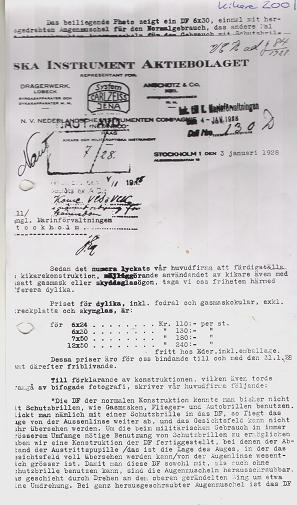 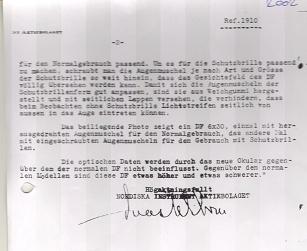
The pictured copy is from Robert Forslund collection; Copyrights picture Robert Forslund
In the offer were following models: 6 x 24; 6 x 30; 7 x 50; 12 x 50 with given prices. Next R. Forslund writes: “Included was a case but no reticule or filters. There is no documentation if any binoculars were ordered.”
In Carl Zeiss Jena catalogue, the binoculars used with Gasmask were described in 1938 (N 123/21 – in our collection).
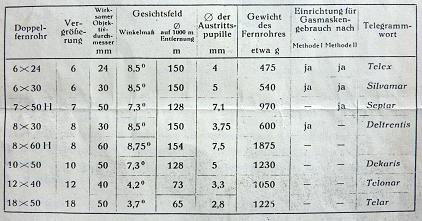
The table from the Carl Zeiss catalogue – 1938
There are listed binoculars available for a special device for gas mask, used with ordinary eyepiece:
- 6 x 24 – Telex;
- 6 x 30 – Silvamar;
- 8 x 30 – Deltrentis ;
Additional group of the binoculars listed are the binoculars fitted with the special Gasmask oculars:
- 6 x 24 – Telex ;
- 6 x 30 – Silvamar;
- 7 x 50 H – Septar;
Next Carl Zeiss catalogue published in January 1940, introduced a description of the mechanism for gas mask used with ordinary binoculars eyepiece and binoculars with a special ocular.
In the catalogue it is said, that the special eyecups can be inserted into ordinary eyepiece of the binoculars:
- 6 x 24 – Telex model;
- 6 x 30 Silvamar;
- 7 x 50 Binoctar;
- 8 x 30 Deltrentis; and
- 12 x 50.
The binocular with the special Gasmask oculars were listed:
- 6 x 24;
- 6 x 30; and
- 7 x 50.
We can conclude that production of the 7 x 50 H was discontinued, in 1940.
Since the beginning of World War II (November 1940) the manufacturer’s name was no longer indicated in full, but a code was applied, the binoculars were given a war cod as well.
In this way the binoculars produced for gas mask received the cods.
Before the cods were applied the Gasmask binoculars were produced by:
- Carl Zeiss Jena ( blc; rln);
- Nedinsco (jux – N.V. Nederlandsche Instrumenten Comp., “Nedinsco” Venlo).
These two Companies were continued the production during the war.
Additional plant of Carl Zeiss Jena factory, produced Gasmask binoculars 8 x 50 was in Czech PÅ™erov - in German Language – Prerau. The company used cod – “dow” - Opticotechna G.m.b.H. Prerau.
*)“Een up-to-date modern gebouw’ Het Nedinsco-complex te Venlo 1921-1945” by Frans Hermans – Published Venlo 1996; ISBN 90-802392-3-2; – in our collection
II. Construction of the eye lenses
The construction of eye lenses in models: 6 x 30 and 7 x 50 are symmetrical. This eyepiece is made up of two identical achromatic lenses. This type of eyepieces, sometimes called ‘Plosal’ type, gives high quality results. Since both lenses are achromatic, colour correction is very good; also field of view is wide and very flat. This eyepiece is the only one to offer a really long eye relief, (about three quarters of its focal length) making for very comfortable observation.
 
Two achromatic lenses fitted in oculars of models; 6x30 and 7x50
The eyepieces are larger diameter then in normal binoculars; 7 x 50 = 24 mm diameter; 6 x 30 = 23 mm diameter.
III. A few words about Gasmask binoculars models
1. Nedinsco binoculars
- 6 x 30 models
We do not have this binocular in our collection. The picture was kindly send by Dr Robert Forslund.
This particularly model is very interesting.
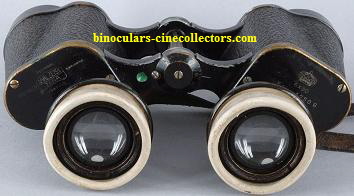 
6 x 30 Nedinsco for the Swedish Army with white rubber; Copyrights picture Robert Forslund
The binoculars were produced for the Swedish Army. The pictured binocular is produced in 1931. The Swedish markings – the big crown is engraved on the right plate. On the left plate is Nedinsco logo.

The most unusual of this binocular is a complete white rubber.
- 7 x 50 models
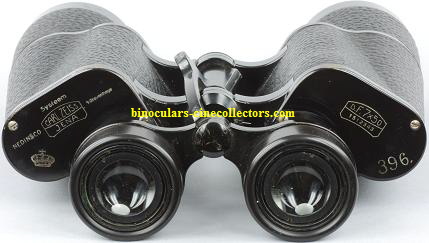
7 x 50 Nedinsco for the Swedish Navy; Copyrights picture Robert Forslund
The binocular is from Robert Forslund collection and is described in the book mentioned above:
“The 7 x50 binocular shown is of a heavy brass construction and has a weight of 1590 g. [...] manufactured around 1930. The Gasmask oculars shifting device is of an unusual construction. The upper bridge moves the ocular parallel to each other and it can be fixed in two positions: observation with or without Gasmask...”
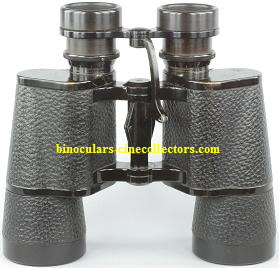
7 x 50 Nedinsco for the Swedish Navy with the oculars shifting device; Copyrights picture Robert Forslund
The Swedish markings – the big crown is engraved on the left plate of the binocular
- Nedinsco logo
The company was used deferent logo. On the 8 x 30 binocular produced for Swiss Army is applied this logo:
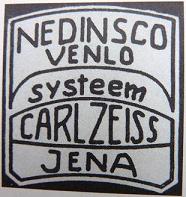
The picture from the book: “Een up-to-date modern gebouw’ Het Nedinsco-complex te Venlo 1921-1945” – Published Venlo 1996 – in our collection
When on the binoculars produced for the Swedish market was applied a different logo, with the -‘s Gravenhage as a place of the Headquarters Company:
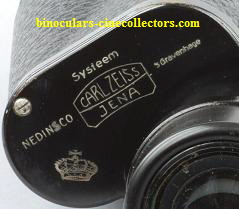
7 x 50 Nedinsco for the Swedish Army
In the Zeiss catalogue – 1931 the Nedinsco logo, with te place -‘s Gravenhage, has a deferent shape:
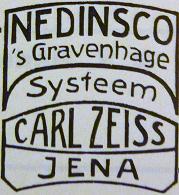
In 1933 Carl Zeiss catalogues the Nedinsco logo specifies Venlo as the production place.

In our collection is the binocular 7 x 50 produced for Dutch army, by Nedinsco in 1955. The logo is placed on the right plate and is deferent:
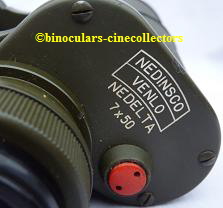
The logo does not contain the words: “Systeem Carl Zeiss Jena”. The Nedinsco Company became independent from Carl Zeiss Jena after the WWII.
2. Carl Zeiss Gasmask binoculars
- D.F 6 x 30 Carl Zeiss Jena – 1934

6 x 30 Carl Zeiss Jena; Copyrights picture Anna Vacani
The marks indicated that the binocular was produced for Marine Artillery – Number 259 G:
On the left plate is engraved the Imperial German eagle.
The prism house is built from aluminum; hinge, oculars and objectives rings are made from brass. The body is covering with vulcanite material.
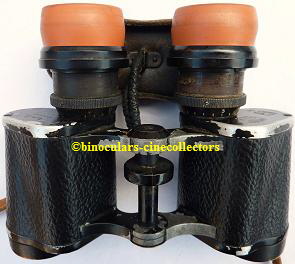 
6 x 30 Carl Zeiss Jena with the extended and pull down eyecups; Copyrights picture Anna Vacani
The 6 x 30 Carl Zeiss Jena symmetrical eyepiece constructions are 22 mm extra long eye relief.
The binocular measurements are:
- Weight; with ocular’s rubbers and the rains cover is 794 g (the rains cover separately- 57 g).
- High 120 mm (including the rubber cup);
The binocular is in the original leather case. The rain cover is made from the hard leather and it is held in place by a leather covered spring in very good condition.
The case is embodied with Carl Zeiss Jena logo. Probably later on was added the swastika and the letter “M”.
The case is amazing in some way. At this moment it is hardly ever seen this quality interior of a case:
The filters, in this unusual holder fitted into the case cover, are missing.
The eye rubbers are not original.
- 7 x 50 H Carl Zeiss – 1938
7 x 50 H Carl Zeiss Jena; Copyrights picture Anna Vacani
The binocular is ‘H’ model – high light transmission fitted with Porro II prism with cemented eyepieces parts.
This model ‘H’ is different from a normal ‘H’ , because it has more eye lens components cemented on the top of the prism. The prism is the same as in the normal ‘H’.
The binocular body is built entirely of a very light alloy, the screws as well.
By using a light yet strong metal for the bodies, Zeiss succeeded in reducing the weight of their Prism Binoculars considerably. As the Zeiss Catalogue from December 1936 stated the weight was reduced from 30 – 40 % on civilian models.
A few Kriegsmarine binoculars still had a lot of brass like UDF binoculars at that time.
The binocular measurements are:
- Weight ; with ocular’s rubbers is 1068 g.;
- High 205 mm(including the rubber cup);
The binocular has the letter ‘T’.
The previous owner removed all paint and number from the top plates.
However, the washer is original and production number is preserved.
The washer of the 7 x 50 H Carl Zeiss Jena; Copyrights picture Anna Vacani
The top plates of the 7 x 50 H Carl Zeiss Jena; Copyrights picture Anna Vacani
The original right plate should have the description:
7 x 50 H from Frank Doherty collection; Copyrights picture Frank Doherty
The objectives of the binocular are the same as in the normal H – model.
The objectives of the 7 x 50 H Carl Zeiss Jena; Copyrights picture Anna Vacani
The graticule is fitted into right ocular with horizontal and vertical graduation.
The graticule of the 7 x 50 H Carl Zeiss Jena; Copyrights picture Anna Vacani
- 7 x 50 Carl Zeiss Flak (Küste) – 1940 –Antiaircraft (Coastal)
7 x 50 H Carl Zeiss Jena Flak (Küste); Copyrights picture Anna Vacani
The binocular was built for coastal anti aircraft observation. More information about these kind of binoculars in “Kriegsmarine binoculars”.
This model is not deferent from normal 7 x 50 models, except the oculars and the ocular retaining tubes. It could be taken out the ocular and the eyepiece tube and exchange with normal 7 x 50 blc. The tread of the ocular is the same as 7 x 50 blc.
This model of the binoculars is fitted with optics fully coated.
The body of this model, like 7 x 50 H model, is built entirely of a very light alloy.
The binocular measurements are:
- Weight ; with ocular’s rubbers is 1058 g.;
- High 175 mm(including the rubber cup);
The binocular arrived to us in a dreadful state. The body was painted over with the black shiny paint. The paint was removed and it appeared that two body parts have a deferent texture of the cover. The top plates were restored before as well.
2 a. 7 x 50 Carl Zeiss war production:
– 7 x 50 blc; rln
During the war the production of Gasmask binoculars, by Carl Zeiss was continued. They were marked with war code: ‘blc’ and at the end of war – ca 1944 ‘rln’.
7 x 50 blc 1941; Production Number 2240192
7 x 50 rln ca 1944; Production Number 69576
The ‘blc’ models were no different from Gasmask 7 x 50 models produced before the war. The only difference was optic. The lenses, objectives and prisms were fully coated.
3. Gasmask produced by other company, during the war
- 8 x 50 dow
During the war was produced model 8 x 50 in a plant of Carl Zeiss Jena factory in Czech (PÅ™erov) - Prerau. The company used cod – “dow” - Opticotechna G.m.b.H. Prerau. The production had begun ca 1941.
8 x 50 ‘dow’ from Frank Doherty collection; Copyrights picture Frank Doherty
The binocular has a different construction of the ocular. The viewer using the binoculars while wearing gas mask or sun glasses has to open the top part of the eyecups. They are fitted on hinges.
The eye lenses are approximately 27 mm diameter.
8 x 50 ‘dow’ from Frank Doherty collection; Copyrights picture Frank Doherty
8 x 50 ‘dow’ from Frank Doherty collection; Copyrights picture Frank Doherty
- 7 x 50 bmk (Srb & Stys, Fabrik praziser Messinstrumente, Prag XVII, Kavalirka 208)
Another Czech Company produced the binoculars with ‘flap-flip” cups.
The binocular was produced in Prag by Company “Srb & Stys” in Prag. During the war the Czech factory was produced equipment for German army. The owner of this binocular is an English collector - James Stewart.
7 x 50 'bmk' from James Stewart collection; Copyrights picture James Stewart
The history of “Srb & Stys” Company is not well known.
Prof. Pavel Hnek, Ph.D. of Czech Technical University of Prague - faculty of Civil Engineering, Department of Special Geodesy and Dipl. Ing. Antonn Svejda - NTM Prag, vedouc odd. exaktnych ved, Prague are writing about the “Srb & Stys” company.
Antonn Svejda has sent us the short history of the “Srb & Stys” Company:
Factory of Precision Mechanics and Optics Srb & Stys, Prague XVII Kavalirka 208
After the establishment of Czechoslovakia a new workshop in Prague Srb and Stys was launched. Workshop made precision mechanics and optics equipment. The spiritual father and founder of the firm was Jaroslav Srb (1892-1967), who started at the Technical University in Prague. Before World War I he was employed by Carl Zeiss in Jena. He chose as a companion the optician and designer Josef Stys (1889-1950), who also started at Carl Zeiss as a mechanic.
Among the first projects the newly established workshop was repairing of microscopes and manufacturing of micro lamp. The company Srb and Stys (based 1919/11/21) settled in the Kavalirka building in Prague XVII - Kosire. In 1921, the firm was offered optical instruments for geodesy, astronomy and meteorology. Department of Defense asked the company in 1921 for theodolites, which designed by Srb started to produce. They delivered the military optical sights (telescopes, periscopes, binoculars) and meteorological instruments. For the Ministry of Education they produced new microscopes with Zeiss optics. In 1937 the company developed additional factory building opposite Kavalirka. There worked about 300 workers on optical glass grinding. The factory supplied military contracts for the Turkish army (quadrants, telescopes, binoculars) and riflescopes for the army of Yugoslavia. Srb and Stys supplied surveying instruments to Greece. The company "Romanian Czechoslovakian Optics" Srb founded in Romania as an affiliate of Srb and Stys. In 1937 the company achieved great development, has already 860 employed workers. Between 1938 and 1939 Srb negotiated the delivery of sighting devices and building a plant in England. Great development of the company ended in 1939 by war and its occupation of Czechoslovakia. During the war the company was under German leadership and fully served the needs of the army. In 1940 Srb was arrested for sabotage. After some time he was dismissed for lack of evidence. The release was forbidden to enter his own factory.
After the war, Srb and Stys climbed back into his race with the intention to stop production of optics for military and begin with civilian production (microscopes, binoculars and theodolites). Immediately in May 1945 “the revolutionary works council” struck in an enterprise against the both owners. It was ready to take over factory "in the hands of the people." The company puts under state control, because he had more than 500 employees, the new "workers' management was named. The factory was renamed Meopta. Company founder; Jaroslav Srb finally leaving, Josef Stys attended there for some time. In 1949 after the February communist revolution Stys was unreasonably arrested and died the next year.
The history of Srb & Stys factory is based on the unpublished memoirs J. Srb (Development Company Srb & Stys) and company documents.
The radio museum organization from Switzerland is given a few words as well: “Company was established under name "Srb a Stys", on the beginning for repair, later for production of mechanical and optical parts for education, medicine, geodetics and military. In 1924 they established own optic lens polishing. Before WW2 company had over 600 employees, own production, research and development, laboratories. During WW2 the production was military type only. After war the company was nationalized under name Meopta n.p. Kosire. The company produced mainly microscopes, binoculars and geodetics devices. In 1963 was the next reorganization, company was renamed to ZPA Kosire. The production focused to precise electromechanical devices - tape memories, power supplies, optical measurement devices for CNC machines. In 1996 company turned bankrupt.”
The binocular could be used while wearing Gasmask or sunglasses.
 |
7 x 50 'bmk' from James Stewart collection; Copyrights picture James Stewart
However, the construction of the eye lenses is not Gasmask structure. In this model eyepiece is not one to offer a really long eye relief. The ocular eye lens are small, much smaller than those fitted in Gasmask binoculars.
A similar version of this model was produced by CZJ, marked ‘rln’ with desiccator cartridges - late 1944. Possibly the Czech factory was a CZJ plant during the war.
IV . A few words about Eyecups rubber
The binoculars with red eyecups described above do not have original rubbers. The original rubbers look today like that:
The copied eyecups have the original height and thickness.
The remains from original eyecup and a copy of eyepiece
The eyecups were shrinking because of an ingredient. The red rubber was always deteriorating faster than black rubber did. The deterioration caused exposure to the sunlight and ozone. When red rubber deteriorated it also can change colour into brown.
This residue of the red rubber was in the bottom of the mounting ring (not exposed for the light)
This kind and colour of the rubber were added as spare parts to the Japanese binocular 20 x 120 Toko. They were packed into black paper and on the box was an instruction not to remove from the package of the spare eyecups until needed for use. It was to prevent them from exposure to sunlight.
The German red rubber was fitted to binoculars to approximately 1940. Afterwards black synthetic rubber was fitted.
Two original black rubber eyecups and what's left from original red eyecups
The black synthetic rubber deteriorated as well. The black original rubber emits a specific smell.
Original black rubber eyecup and copied eyecup
We hope that this short article will let our readers to systematize the knowledge with reference to Gasmask binoculars.
We will be happy to hear about your Gasmask binoculars.
|
|